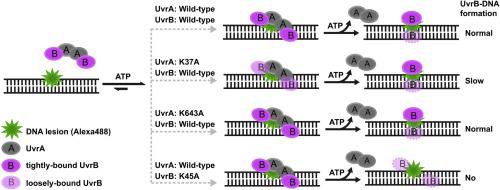DNA Repair ( IF 3.8 ) Pub Date : 2020-11-25 , DOI: 10.1016/j.dnarep.2020.103024 Thanyalak Kraithong 1 , Jeerus Sucharitakul 2 , Chittanon Buranachai 3 , David Jeruzalmi 4 , Pimchai Chaiyen 5 , Danaya Pakotiprapha 6

|
Nucleotide excision repair (NER) stands out among other DNA repair systems for its ability to process a diverse set of unrelated DNA lesions. In bacteria, NER damage detection is orchestrated by the UvrA and UvrB proteins, which form the UvrA2-UvrB2 (UvrAB) damage sensing complex. The highly versatile damage recognition is accomplished in two ATP-dependent steps. In the first step, the UvrAB complex samples the DNA in search of lesion. Subsequently, the presence of DNA damage is verified within the UvrB-DNA complex after UvrA has dissociated. Although the mechanism of bacterial NER damage detection has been extensively investigated, the role of ATP binding and hydrolysis by UvrA and UvrB during this process remains incompletely understood. Here, we report a pre-steady state kinetics Förster resonance energy transfer (FRET) study of the real-time interaction between UvrA, UvrB, and damaged DNA during lesion detection. By using UvrA and UvrB mutants harboring site-specific mutations in the ATP binding sites, we show for the first time that the dissociation of UvrA from the UvrAB-DNA complex does not require ATP hydrolysis by UvrB. We find that ATP hydrolysis by UvrA is not essential, but somehow facilitates the formation of UvrB-DNA complex, with ATP hydrolysis at the proximal site of UvrA playing a more critical role. Consistent with previous reports, our results indicated that the ATPase activity of UvrB is essential for the formation of UvrB-DNA complex but is not required for the binding of the UvrAB complex to DNA.
中文翻译:

实时研究 UvrA 和 UvrB 在 DNA 损伤识别过程中对 ATP 水解在核苷酸切除修复中的作用
核苷酸切除修复 (NER) 在其他 DNA 修复系统中脱颖而出,因为它能够处理多种不相关的 DNA 损伤。在细菌中,NER 损伤检测由 UvrA 和 UvrB 蛋白协调,形成 UvrA 2 -UvrB 2(UvrAB) 损伤传感复合体。高度通用的损伤识别是通过两个依赖于 ATP 的步骤完成的。在第一步中,UvrAB 复合物对 DNA 进行采样以寻找病变。随后,在 UvrA 解离后,在 UvrB-DNA 复合物中验证了 DNA 损伤的存在。尽管细菌 NER 损伤检测的机制已被广泛研究,但 UvrA 和 UvrB 在此过程中结合和水解 ATP 的作用仍未完全了解。在这里,我们报告了在病变检测过程中 UvrA、UvrB 和受损 DNA 之间实时相互作用的预稳态动力学 Förster 共振能量转移 (FRET) 研究。通过使用在 ATP 结合位点具有位点特异性突变的 UvrA 和 UvrB 突变体,我们首次表明 UvrA 从 UvrAB-DNA 复合物的解离不需要 UvrB 的 ATP 水解。我们发现 UvrA 的 ATP 水解不是必需的,但以某种方式促进了 UvrB-DNA 复合物的形成,其中 UvrA 近端位点的 ATP 水解起着更关键的作用。与之前的报告一致,我们的结果表明 UvrB 的 ATPase 活性对于 UvrB-DNA 复合物的形成是必不可少的,但不是 UvrAB 复合物与 DNA 结合所必需的。

























 京公网安备 11010802027423号
京公网安备 11010802027423号